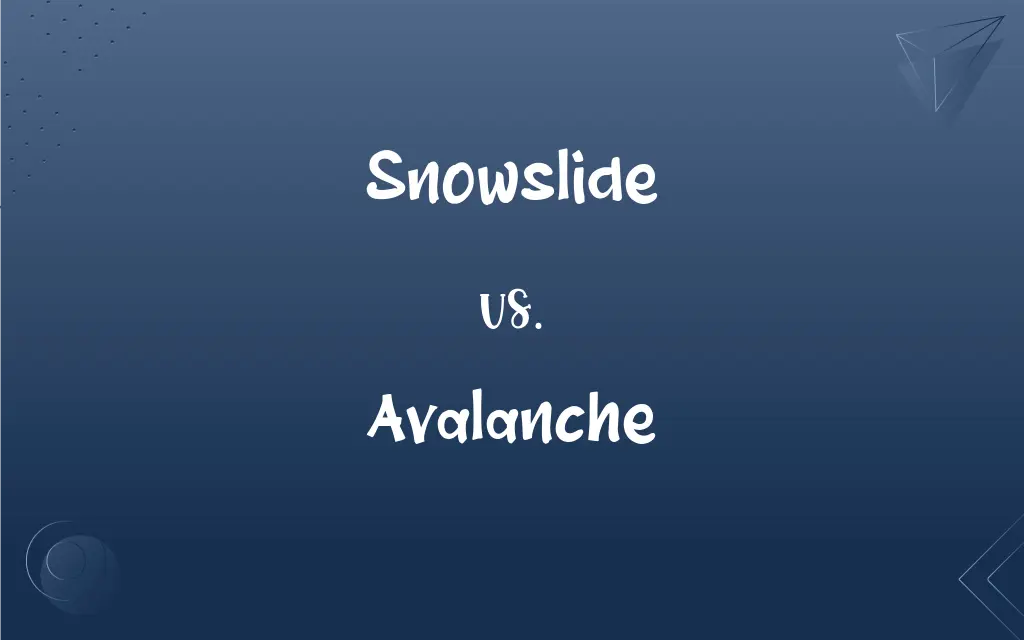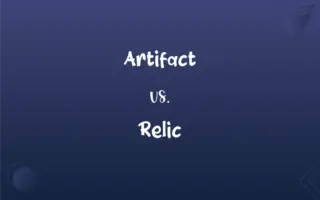Snowslide vs. Avalanche: What's the Difference?
Edited by Aimie Carlson || By Harlon Moss || Updated on November 2, 2023
A snowslide is a sudden slide of snow down a slope, while an avalanche is a large mass of snow, ice, and debris falling rapidly down a mountainside.

Key Differences
Snowslide and avalanche both involve the movement of snow down a slope, but their scale and impact differ. A snowslide is typically a smaller displacement of surface snow that slides down a hill or mountain. Avalanches, on the other hand, involve a much larger volume of snow and can also include ice, rocks, and other debris.
Snowslides can be seen as a form of a miniature avalanche, often less destructive due to their size. Avalanches are well-known for their potential to cause significant damage and danger, being powerful natural events that can destroy forests, buildings, and even claim lives.
The term snowslide is often used to describe a more controlled or less severe event, which may occur in areas where snow accumulation is not as deep. Avalanches carry a connotation of unpredictability and greater risk, usually requiring careful monitoring in mountainous regions, especially during winter.
A snowslide may occur in a specific circumstance where the snowpack is disturbed, whereas an avalanche can be triggered by various factors, including heavy snowfall, rapid warming, or human activity. The force behind an avalanche makes it a critical concern for mountain communities and outdoor enthusiasts.
While a snowslide can sometimes refer to intentionally triggered snow movement for safety, an avalanche generally refers to a natural disaster scenario. Both require respect and awareness for those living in or traveling through snowy terrains.
ADVERTISEMENT
Comparison Chart
Definition
A slide of snow down a slope.
A massive fall of snow, often with ice and debris.
Scale
Generally smaller in size.
Typically larger and more destructive.
Associated Danger
Less dangerous compared to avalanches.
High potential for danger and damage.
Occurrence
Can happen on small hills or slopes.
Usually occurs in mountainous regions.
Triggers
Often a single layer of snow slipping.
Multiple potential triggers, including layered snowpack.
ADVERTISEMENT
Snowslide and Avalanche Definitions
Snowslide
A slide of accumulated snow down a slope.
The children watched the snowslide from a safe distance.
Avalanche
A rapid flow of snow down a slope.
The avalanche roared down the mountain, uprooting trees.
Snowslide
The downward movement of snow without significant debris.
A snowslide covered the path in a thick layer of snow.
Avalanche
A cascade of snow, often including ice and rocks.
The avalanche warning system was activated after heavy snowfall.
Snowslide
A sudden descent of snow on a hillside.
Skiers were alerted to a small snowslide near the trail.
Avalanche
A natural disaster involving a mass of snow.
Survivors of the avalanche shared their harrowing stories.
Snowslide
An event where surface snow layers slide down.
The park ranger explained how to spot signs of a snowslide.
Avalanche
A phenomenon where a snowpack becomes unstable and moves swiftly.
They heard the unmistakable rumble of an avalanche in the distance.
Snowslide
A minor release of snow in an area.
The cabin was designed to withstand the pressure of a snowslide.
Avalanche
A powerful and sudden release of snow accumulation.
The ski resort implemented measures to mitigate avalanche risks.
Snowslide
An avalanche of snow.
Avalanche
A fall or slide of a large mass of material, especially of snow, down a mountainside.
Snowslide
An avalanche of snow
Avalanche
A massive or overwhelming amount; a flood
Received an avalanche of mail.
FAQs
Are avalanches predictable?
Avalanches can sometimes be predicted, but they often occur without warning.
How fast can an avalanche move?
Avalanches can reach speeds of over 80 miles per hour.
Can avalanches only occur in winter?
Avalanches are most common in winter but can occur whenever there is snowpack.
How is an avalanche different from a snowslide?
An avalanche is larger, often including ice and debris, and more destructive.
What are common triggers for a snowslide?
A snowslide can be triggered by disturbances like footsteps or skiing.
What is a snowslide zone?
A snowslide zone is an area prone to snowslides due to its terrain and snow conditions.
Can you hear a snowslide coming?
Snowslides are usually silent, unlike the rumbling of an avalanche.
What defines a snowslide?
A snowslide is a movement of snow down a slope on a smaller scale.
What safety measures exist for avalanches?
Safety measures include avalanche forecasting, education, and controlled explosions.
Can a snowslide become an avalanche?
A snowslide can evolve into an avalanche if conditions permit.
Can a snowslide cause an avalanche?
Rarely, but a snowslide can destabilize the snowpack and trigger an avalanche.
Is a snowslide always natural?
Not always; snowslides can be artificially triggered for safety.
Are snowslides common in all snowy regions?
Snowslides can occur in any snowy area with sloping terrain.
What is avalanche control?
It’s the process of mitigating avalanches through planning, monitoring, and controlled explosions.
Do snowslides and avalanches impact wildlife?
Yes, they can alter habitats and pose a threat to animals.
What is an avalanche airbag?
It's a safety device that inflates to keep you on the surface during an avalanche.
Can snowslides be beneficial?
In controlled situations, they can help stabilize snowpack and reduce larger avalanche risks.
Do avalanches affect climate?
Indirectly, as they can reshape landscapes and affect vegetation.
How can you survive an avalanche?
Survival tactics include using avalanche beacons, staying above the snow, and creating air pockets.
Are snowslides a concern for drivers?
Yes, snowslides can affect roads and driving conditions.
About Author
Written by
Harlon MossHarlon is a seasoned quality moderator and accomplished content writer for Difference Wiki. An alumnus of the prestigious University of California, he earned his degree in Computer Science. Leveraging his academic background, Harlon brings a meticulous and informed perspective to his work, ensuring content accuracy and excellence.
Edited by
Aimie CarlsonAimie Carlson, holding a master's degree in English literature, is a fervent English language enthusiast. She lends her writing talents to Difference Wiki, a prominent website that specializes in comparisons, offering readers insightful analyses that both captivate and inform.
































































